Learn how to cook beans from scratch at home. This super simple step-by-step tutorial will give you creamy, delicious beans every time at a fraction of the cost of canned beans. Plus 7 bonus methods for de-gassing beans too!
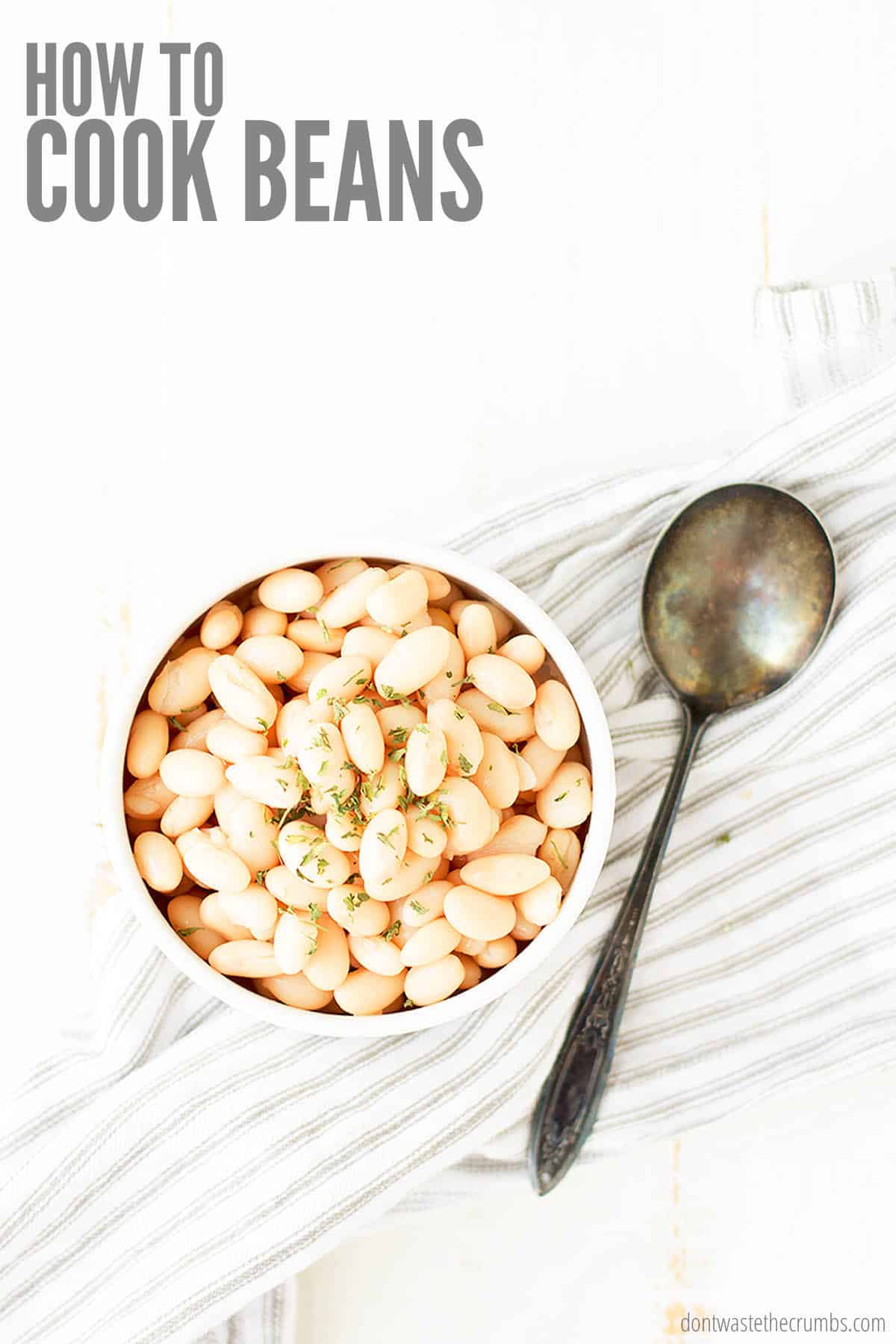
Cooking from scratch is one of the best ways to reduce grocery spending. And pound for pound, beans are one of the most affordable staples you can keep in your pantry.
However, not everyone knows how to cook dry beans, and many are intimidated by the process.
Let me show you how easy it is to get the best of both worlds – cooking from scratch and including beans in your meal plans – with a step-by-step tutorial on how to cook beans!
WHY BOTHER COOKING DRY BEANS
You may wonder if there’s any benefit to cooking dried beans versus buying cans of beans. The three biggest reasons are:
- Dry beans are cheaper. Regardless of what type of dry beans you cook (i.e. pinto beans, chickpeas, black beans, kidney beans, red beans, lima beans, cannellini, etc.), it’s cheaper to cook your dry beans than it is to buy canned. (Here’s the cost breakdown if you want to nerd out on the math.)
- Dried beans are easier to digest. Starting with dried beans gives you the flexibility to soak, cook them slowly, and add other ingredients to counteract the negative side effects that canned beans can cause. Read on for my easy method for soaking beans and tricks for de-gassing beans.
- Dried beans are less popular. Remember the year when grocery store shelves were empty? Canned beans were quick to disappear, but dried beans still hung around. Why? Because most people don’t know how to cook beans.
- Bonus: Dry beans last forever. They’re the perfect pantry staple! Unofficially, dry beans will last indefinitely if they’re stored properly. Think of an airtight container in a cool, dry spot. (I use 5-gallon food-grade buckets with gamma lids. The cheapest buckets are at Tractor Supply for $5. These are the lids I bought, but there might be some in multi-packs for a better price per lid.)

INGREDIENTS FOR COOKING BEANS
In the most basic of recipes for cooking beans, you only need two ingredients:
- Dried Beans
- Water
It doesn’t matter what type of bean you choose – black beans, white beans (cannellini beans or navy beans), pinto beans, garbanzo beans – this method works for them all.
Bay leaves and sea salt add a subtle flavor, and that’s why I include them in my dried beans recipe, but they’re optional. Cooking dried beans is a fantastic way to make low-sodium or salt-free beans!
Psst…Did you know that many salts contain MICROPLASTICS? It’s a sneaky toxin that may be in your everyday salt, and thus your everyday food (um, gross). I love Ava Jane’s Kitchen because their salt is FREE of microplastics, and it tastes delicious! (PLUS, you can get a free 8oz. bag of sea salt – just pay shipping and handling!)
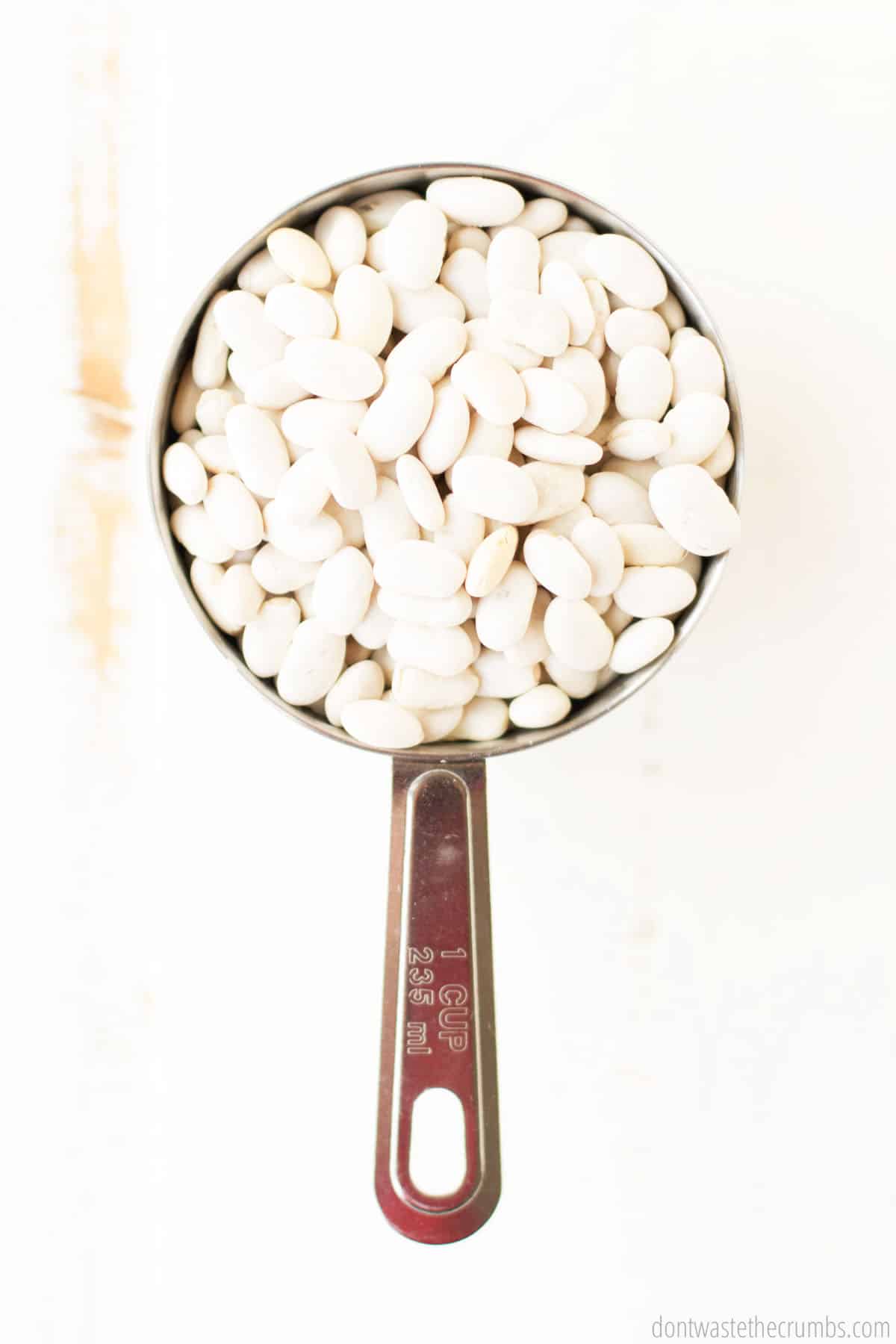
BEFORE YOU COOK: CONSIDER SOAKING DRIED BEANS
It’s not NECESSARY to soak dried beans before cooking them, but it’s something you should consider. Here’s why:
- Soaked beans produce less flatulence. Dried beans contain an enzyme called oligosaccharides, which is difficult for a lot of people to digest. The body will continue to try to break this enzyme down as it gets further into the digestive system and gas is produced as a byproduct. Soaking dried beans (and tossing the soaking liquid) can help remove 75-90% of the oligosaccharides.
- Soaked beans cook faster. Cooking dry beans without soaking takes several hours. By soaking the beans first, you can reduce the cooking time to as little as 30 minutes, depending on the type of bean.
- Soaked beans taste better. Beans tend to be softer and more evenly cooked when they’re soaked versus cooked straight from dry.
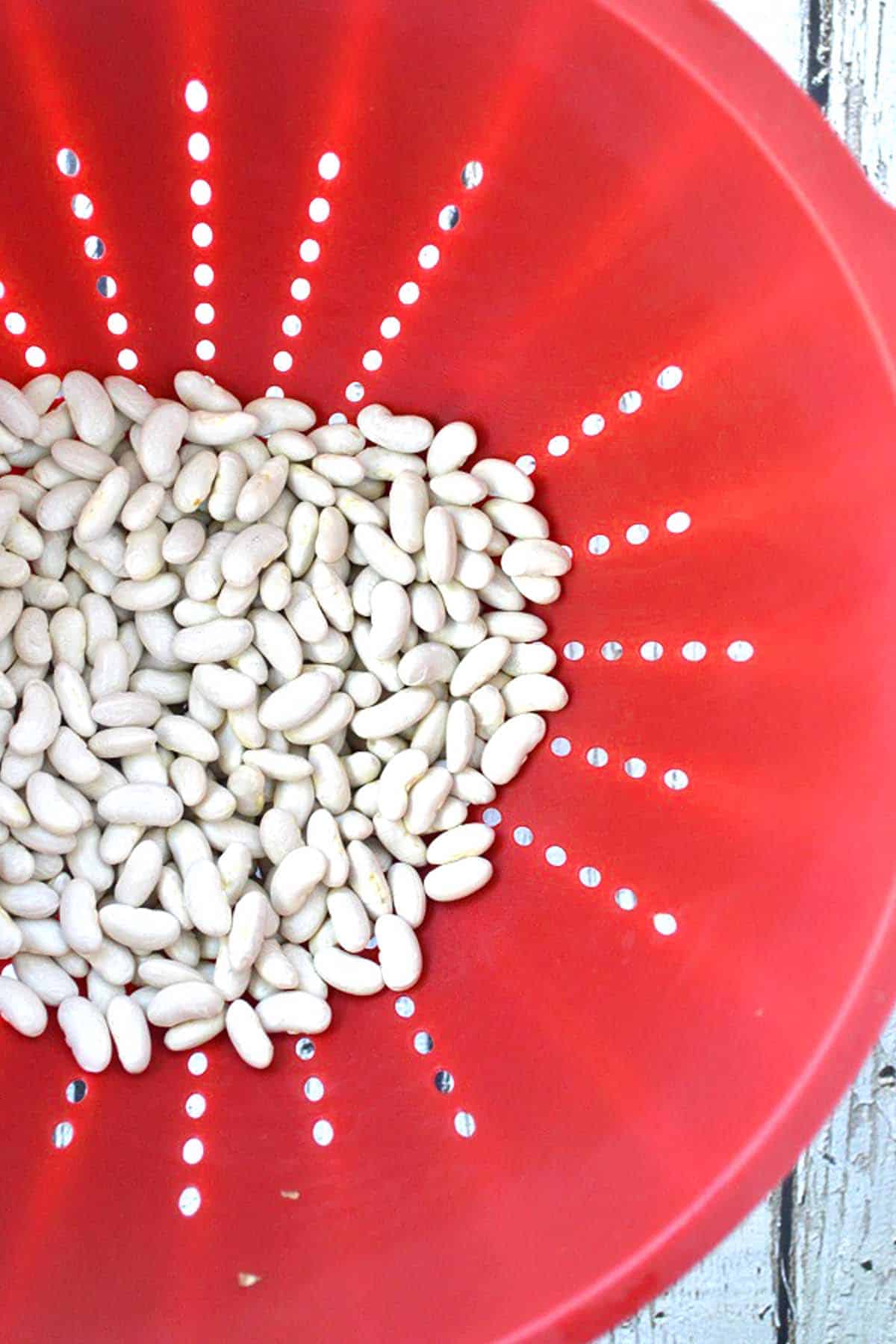
HOW TO COOK BEANS: STOVETOP METHOD
Step 1: Pick them over. Rinse your beans in cool water in a colander and pick out any that are broken, deformed, or discolored. Rinsing also helps to remove any dust, dirt, and debris.
Step 2 (optional): Soak the beans. Follow your preferred method of soaking below, if desired. Be sure to discard the soaking liquid and rinse the beans with fresh water thoroughly before cooking.
Step 3: Place the soaked or unsoaked beans in a large pot, add 1 teaspoon of salt (if using) and cold water. Generally speaking, you need 1 quart of water for every 1 cup of dry beans.
Step 4: Simmer gently over medium heat and allow the dried beans to cook until they reach your desired tenderness, periodically checking the beans for doneness. Add more water as needed to ensure the beans are fully submerged during the cooking process.
Step 5: When the beans are almost done, you can add additional seasonings like ground black pepper, granulated garlic, onion powder, cumin, or Italian Seasoning, or even frozen herbs.
- How to cook beans: partially cooked. Partially cooked beans are still fairly firm but are cooked enough that you can split them in half with a spoon. This will take anywhere from 45-90 minutes. (This is ideal in situations when the beans will be cooked again – like in soups or stews.)
- How to cook beans: fully cooked. Fully cooked beans are softer and more tender. This will take anywhere from 45 minutes to 2 hours of cooking time. (This is ideal when you need soft beans immediately, in dishes like Hummus or Greek Quinoa Salad.)
Drain bean cooking liquid and allow the beans to cool completely before storing. Store cooked beans in an airtight container or resealable bag in the refrigerator for up to 5 days, or in the freezer for up to 6 months.
Note: You can use this method for all types of beans, but please note that red kidney beans must be boiled for 10 minutes before cooking (regardless of what method of cooking you choose) due to their higher levels of phytohemagglutinin, which can cause digestive distress.
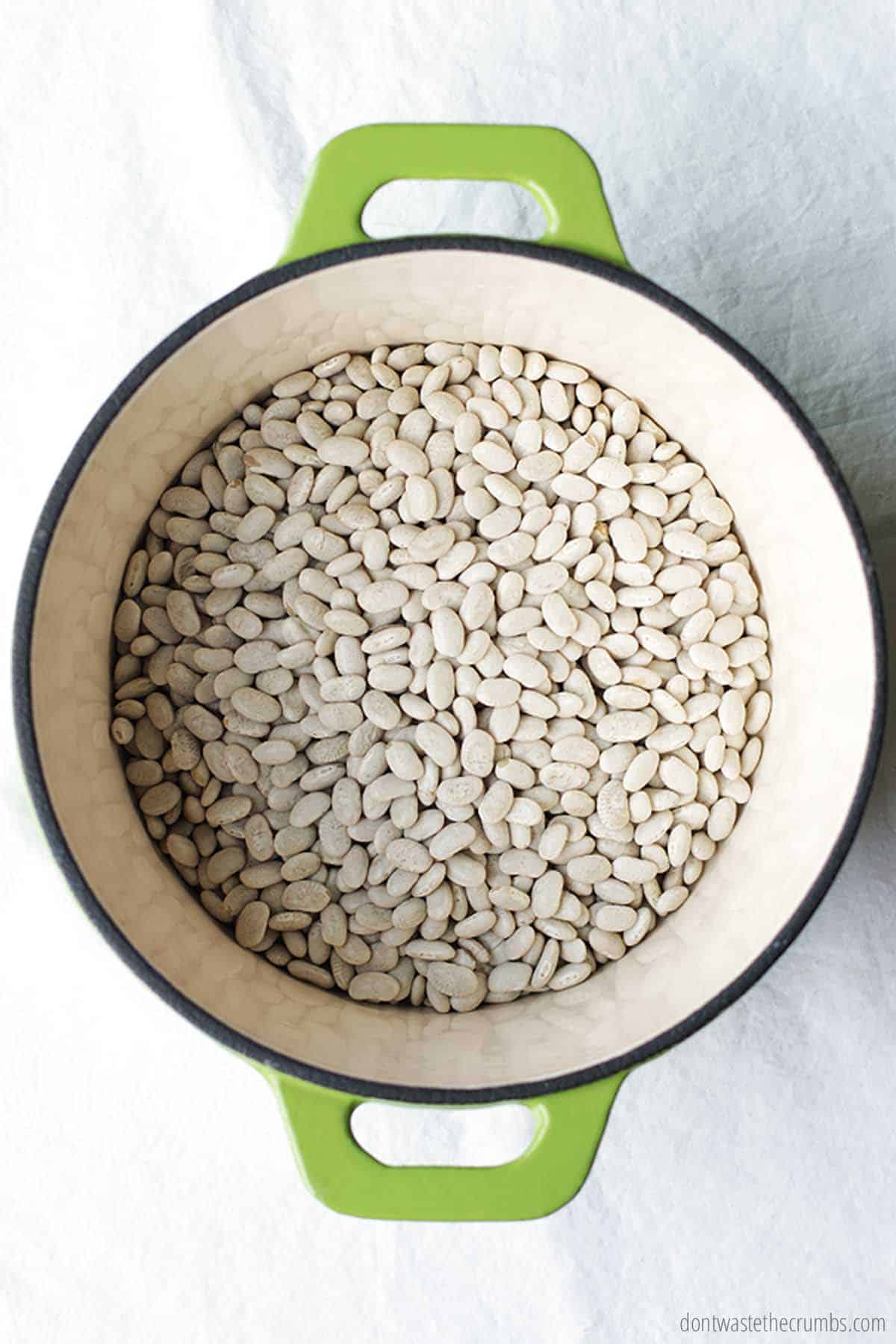
HOW TO COOK DRY BEANS IN A SLOW COOKER
Follow steps 1-2 above but place the beans in a crock pot instead of in a large pot on the stove. Allow the dry beans to cook for 5-6 hours on LOW or 3-4 hours on HIGH. For step-by-step details, follow this Slow Cooker Beans tutorial.
HOW TO COOK DRIED BEANS IN AN INSTANT POT
Follow step 1 above and then place the dried beans in the pressure cooker instead of a large pot on the stove. Press the “manual” or “pressure cook” button so that it’s set to high pressure and adjust the timer to 25-40 minutes, depending on the type of bean. For step-by-step details, follow this Instant Pot Beans tutorial.
Soaking beforehand is not necessary when cooking beans in the Instant Pot since they cook more quickly and evenly. However, if you want to soak the dry beans beforehand, cut the cooking time in half.
HOW TO COOK BEANS TO REDUCE GAS (HOW TO SOAK BEANS)
There’s no right or wrong way to soak beans, so I’ll share my two methods for soaking dry beans. (If beans tend to make you gassy, you’ll want the long soak method.)
QUICK SOAK METHOD:
- Rinse your beans well and pick out any that are broken, deformed, or discolored.
- Place your beans in a large stock pot, add 1 teaspoon of salt, and cover with water 2” past the top of the beans. (If you have hard water, use distilled or purified water to cook beans.)
- Bring the beans just to a boil. Stir, cover with a lid, and remove from the heat. Let the beans sit in the hot water until the water has cooled to room temperature, about 30-45 minutes.
- Drain the beans and repeat the process for an additional soak (starting with step 2) or follow the recipe below to cook the beans.
Note: This is the method recommended by the USDA, but you should limit the soak time for cannellini beans to just 30 minutes. They tend to get soft very quickly.
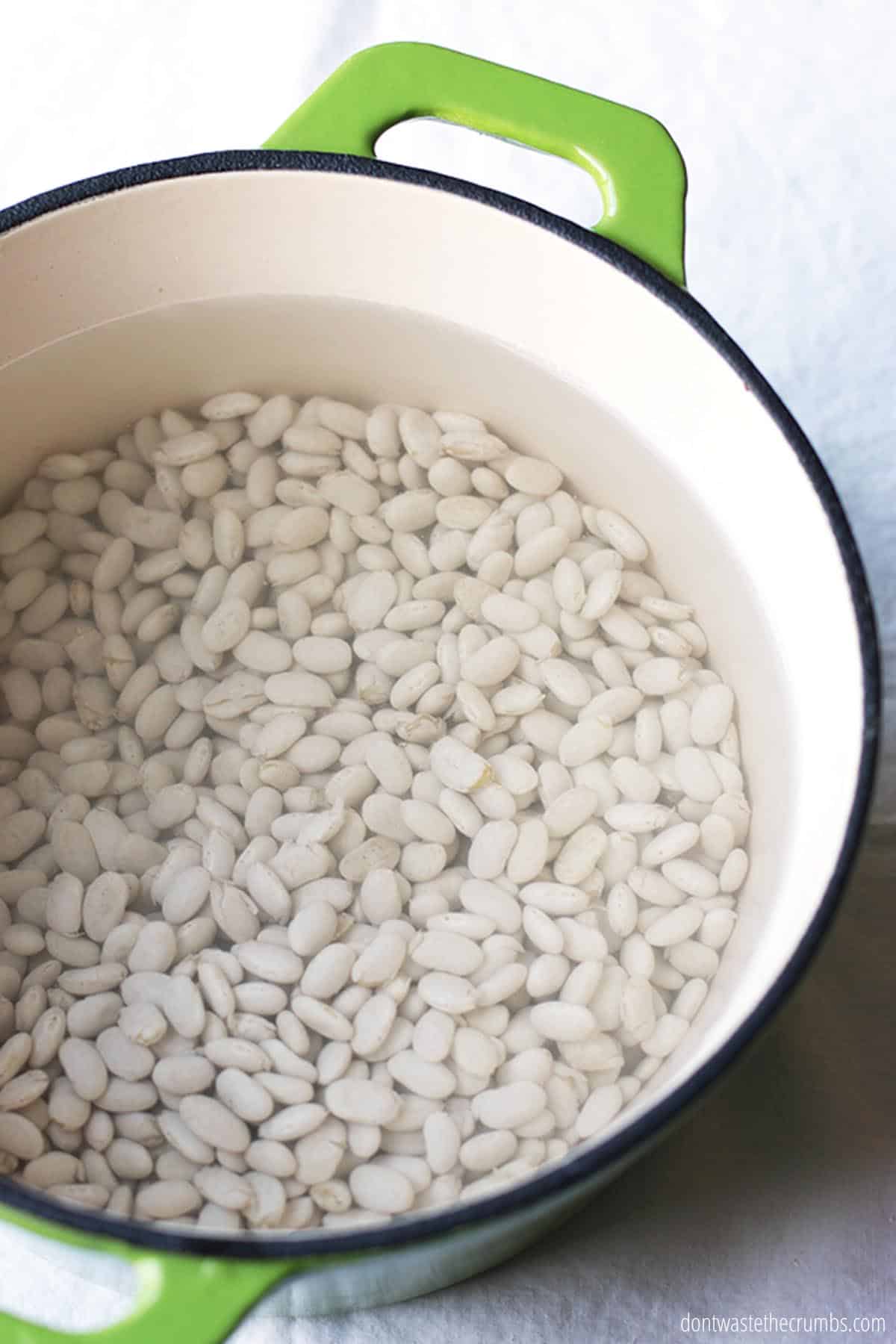
LONG SOAK METHOD:
- Rinse your dried beans well and pick out any that are broken, deformed, or discolored.
- Place your beans in a large stock pot or large bowl and cover with water 3” past the top of the beans. (If you have hard water, use distilled or purified water to cook beans.)
- If you like seasoned beans, add 1 teaspoon of salt to the water.
- Cover beans and let soak at room temperature for 4-8 hours (or overnight) or refrigerate them for up to 24 hours.
- Drain the beans and either repeat the process (starting with step 2) or follow the recipe card below to cook the beans.
For either method, it’s imperative that you drain the beans and not consume the soaking liquid to avoid gassiness. If you’re trying to conserve water, consider using it to water your plants.
HOW LONG TO SOAK BEANS?
I shared two methods for soaking beans above, but if you need a timer on how long to soak, you need about 45 minutes for the quick soak, and up to 12 hours for the long soak.
Both methods can be repeated – depending on how sensitive your digestive system is – which affects the total soaking time.
7 METHODS FOR REDUCING GAS IN DRIED BEANS EVEN MORE
Anyone who learns how to cook beans has a trick or two up their sleeve for reducing the gas in beans. Some methods work for some people, some methods don’t. It’s honestly a matter of personal preference and a little bit of trial and error to see which method works best for YOU.
- Pacific Kombu. This is a specific type of seaweed that helps to break down the oligosaccharides in beans. You add a 1” piece to the beans in the soaking process and again when the beans are cooking. This is my personally preferred method and trust me, you can’t taste the seaweed when the beans are done.
- Baking Soda. Some swear that adding a teaspoon of baking soda to a pound of dried beans reduces the gas in beans, but any bubbling you see is merely excess carbon dioxide. If you try this trick, remember that baking soda is alkaline and will decrease the cooking time by 50%. A faster cooking time means less time to reduce the oligosaccharides in the beans.
- Bay Leaves. Others swear that bay leaves tenderize the beans and help with digestion, but in my experience, my method of soaking and rinsing de-gasses better. (But I still add a bay leaf for flavor!)
- Lemon Juice or Whey. Still others think that adding lemon juice or whey (the liquid from yogurt) will help get rid of the gas in beans because they slow down the cooking time. I haven’t found this to be the case personally but be careful if you try this trick – acidic water can sometimes lead to hard beans, despite a very long cooking time.
- Try pressure-cooking beans. I’m sharing several methods for cooking beans in this post, but some readers have shared that pressure-cooked beans are less gassy for them. Here’s my Instant Pot Beans tutorial.
- Add ajwain (carom seed) and epazote. Ajwain is an Indian spice that tastes like cumin and thyme and is traditionally used for an upset stomach. Epazote is a South American herb.
- Take Beano. There’s an enzyme derived from the fungus Aspergillus niger that helps to digest oligosaccharides. If all else fails, take Beano (or another brand with this enzyme) with your meal.
Generally speaking, a long soak time, a long cooking time, and adding your own “trick” to the pot of beans will greatly reduce how much gas is produced when you enjoy your home-cooked beans. And by cooking and freezing a big batch of dried beans ahead of time, you get the convenience of canned beans without the side effects!
COOKING DRIED BEANS – EXCEPTIONS TO THE RULE
This is the method I use to cook almost every kind of dried beans, but there are a few legumes that are exceptions to the process:
- Lentils. Lentils don’t require soaking at all. There are several varieties of lentils – green, brown, black, and red – and each requires different cooking times. Here’s how to cook green or brown lentils in the Instant Pot.
- Split Peas. Green and yellow split peas also do not require soaking.
- Adzuki Beans. Adzuki are sweet and nutty and one of my favorite beans, and they don’t require any soaking. They’re ready in about 40 minutes from start to finish.
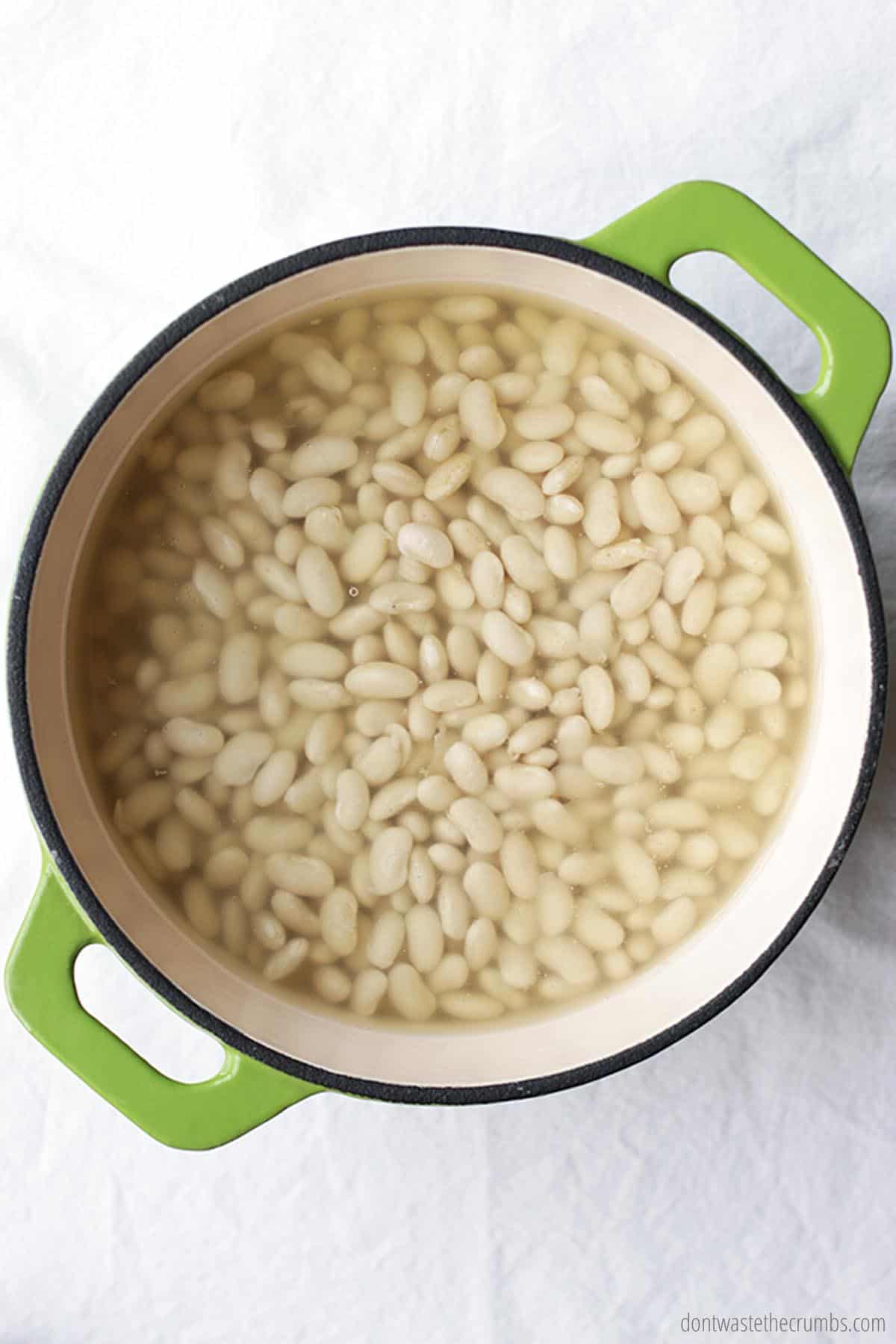
COOKING BEANS FAQS
What is the best way to cook beans?
I recommend the above method of cooking beans on the stovetop as the best way to cook beans – especially for those with sensitive digestive systems. It’s the best way to ‘de-gas’ the beans and cook them tender.
Do you have to soak beans before cooking them?
It’s not NECESSARY to soak dried beans before cooking them, but it’s something to consider if you have difficulty digesting beans. If you don’t have time to make soaked beans, or just don’t want to, I recommend my recipe for Instant Pot Beans.
Should you add salt before cooking beans?
If you’ve ever heard that adding salt before cooking your beans will prevent the beans from cooking through, you heard wrong. You can salt your beans before, during, or after cooking and they taste much better!
Why are my beans hard?
Dry beans that have been cooking for a long time (hours) without getting soft are usually the result of old beans, having hard water, or having something acidic like lemon juice or Apple Cider Vinegar in the pot (which can slow down cooking).
How many cups of beans does cooking dry beans make?
One pound of dry beans yields 3-5 cups of cooked beans, depending on the size of the dry bean. Garbanzo beans (chickpeas) make about 3 cups per pound of dry beans, while black beans make about 5 cups per pound of dry beans.
You need about 1 ½ cups of cooked beans in place of one 15oz can of bean
MY FAVORITE DRIED BEAN RECIPES
Now that you know how to cook beans, you can use those cooked dried beans in these yummy recipes.
- Black Bean Brownies
- Tortilla Soup
- Southwest Chicken Salad
- Enchilada Casserole
- Black Bean and Corn Salsa Tacos
- Slow Cooker Vegetable Curry
- Our Favorite Rice and Beans Recipe
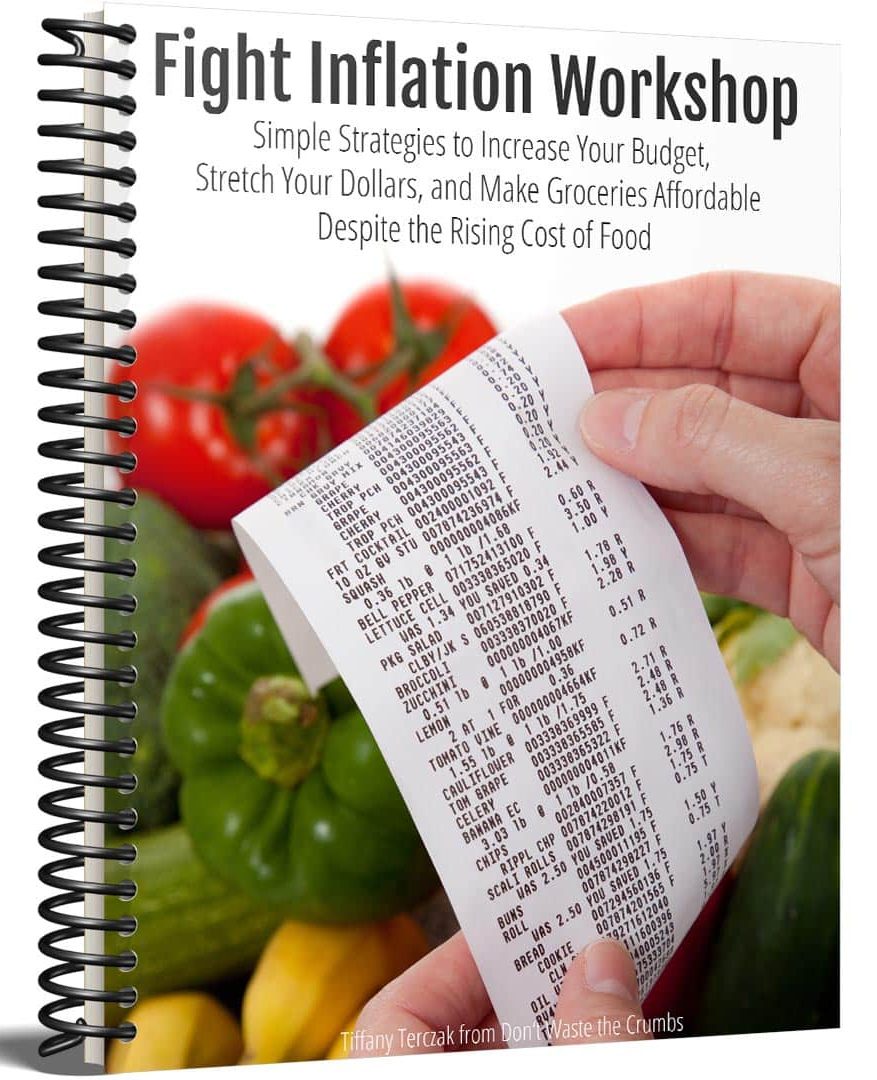
Fight Inflation Workshop!
Sign up for my FREE Fight Inflation Workshop and learn simple strategies to save money, even with rising food costs!WATCH HOW TO SOAK AND COOK BEANS FROM SCRATCH
How to Soak and Cook Dried Beans from Scratch
Learn how to cook beans from scratch at home. This super simple step-by-step tutorial will give you creamy, delicious beans every time at a fraction of the cost of canned beans. Plus 7 bonus methods for de-gassing beans too!
- Prep Time: 8-24 hours
- Cook Time: 2 hours
- Total Time: 26 hours
- Yield: 6 cups 1x
- Category: How To
- Method: Stovetop
- Cuisine: American
Ingredients
- 1 lb dry beans
- water
- 3–5 Tbsp whey or lemon juice (if making black beans)
Instructions
- Place beans in a colander and rinse well. Remove any whole or partial beans that are significantly discolored. You also want to check for pebbles and clumps of dirt.
- Measure beans into a large stockpot. Add 4 cups of water for every 1 cup of beans. One pound of dry beans yields 3-5 cups, depending on the beans, so you’ll need approximately 3-5 quarts of water.
- If you’re making black beans, add 1 Tbsp whey or lemon juice for each cup of dry beans.
- Allow the beans to sit undisturbed for at least 8 hours, or up to 24.
- After soaking, strain the beans into the colander and rinse very, very well with cold water.
- Return the beans to the stockpot and add the same amount of water you originally used, plus an extra cup for each cup of beans.
- Place the beans on the stovetop and bring the water just to a boil. Turn off the heat and cover the beans. Allow the beans to sit undisturbed, for 2-8 hours.
- Strain beans into the colander and again, rinse very, very well with cold water.
- Return the beans to the stockpot and cover with water so that the water line is at least 2″ above the beans. Bring the beans to a very low simmer and allow them to cook until desired tenderness. For partially-cooked beans, this will take anywhere from 45-90 minutes. For fully-cooked beans, this will take anywhere from 45 minutes to 2 hours.
- Periodically check the beans for doneness and add more water as needed to ensure the beans do not dry out while cooking. Season with salt and pepper to taste when the beans are almost done.
- Drain and allow the beans to cool before storing.
Notes
- Beans. Cook black beans, white beans, pinto beans, and garbanzo beans, which are the ones I cook with most often.
- Cooking Methods. Cook beans on the stovetop (like in the recipe above), in the slow cooker, or the Instant Pot (you don’t have to soak first with the Instant Pot!).
Nutrition
- Serving Size: 1
- Calories: 167

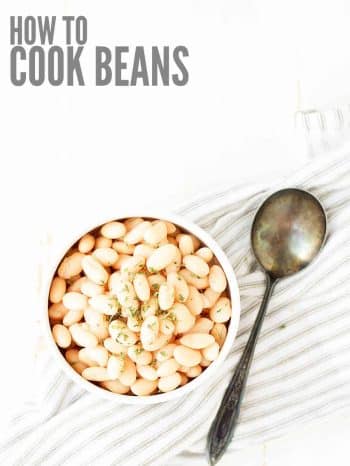
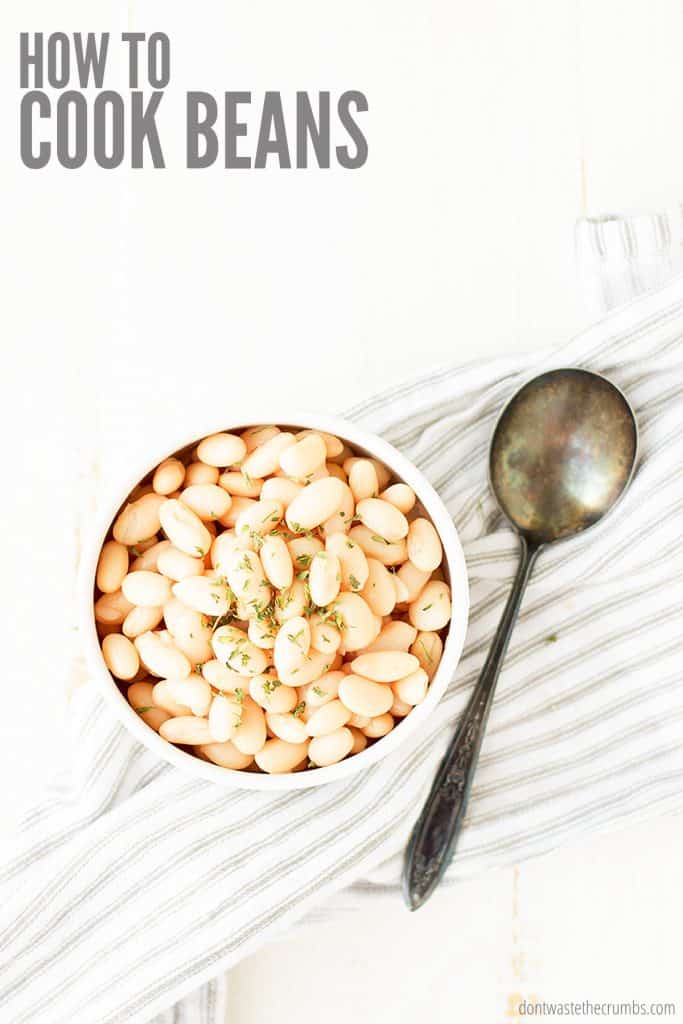
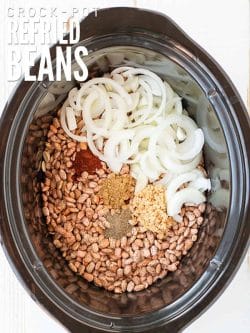
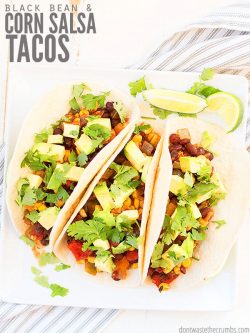
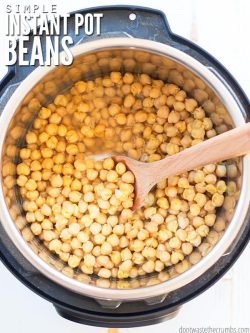


I am sure these will turn out great! I did the two-soak method but want to ask if cooking in a crockpot instead is ok?
Hi Meg,
Yes!
When you soak the beans, do you leave it on the counter or put in the fridge while soaking?
Hello ST,
The beans can be soaked at room temperature for 4-8 hours, or refrigerate them for up to 24 hours.
I have used this recipe again and again–it’s really my favorite! I have a question though: I saw your answer about discarding the water that the beans were cooked in. So we can’t save the final batch of water (the one from your last steps) when we’re cooking chickpeas for aquafaba?
Hi Jo! Aquafaba will come from the water you cook the beans in. Not the water from soaking. I hope that helps!
I went through your process, SOLD ! Made a white bean and ham took extra care to eliminate hulls. I think that helped also. Added a touch of cayenne and a bay leaf . Surprisingly it does not need salt and has just the right amount of heat. Thanks!
Hi G!
Thanks for sharing! We are so glad you like the process. 🙂
Hi there,
I’ve been trying to find out if it is completely necessary to rinse dry beans both before and after cooking, as I have seen many people rinse but then add the uncooked legumes be it beans, lentils etc into their recipe and then cook everything together and eat it just like that!
This always bothers me as I feel that unpleasant things are left in the pot of whatever you’re making if you’re not rinsing the cooked beans afterwards, so I was hoping to get your opinion on that please.
Thanks! 🙂
Hi Bridget,
Sorry for the delay in responding. You can definitely gently rinse after cooking and before adding your beans to your recipe. Depending on the recipe, I have done it both ways. I hope this helps. 🙂
Hi Tiffany. I guess I got confused, this is a longer process than I normally do. I did the original soak +/-24 hrs and rinsed. Then I did a 2nd soak, which ended up being overnight again, but I didn’t bring to a boil 1st. I thought I was soaking twice, then cooking so I left them sit. I’m using Great Northern. They smell fine, like beans. I rinsed again and am bringing them to a boil now. I just wanted to make sure they are still ok to use since they’ve been sitting out so long reconstituted?
Thanks!
Anne,
I would normally refrigerate beans that are reconstituted over 24 hours. Hope this helps.
How long are the beans good for in the refrigerator once they have been soaked and cooked?
Hi Summer, They are good for 4-5 days!
some say baking soda helps the
‘no gas’ process. Any suggestions?
It might Elaine, but we recommend soaking, rinsing and cooking well to remove that. 🙂
Baking soda (sodium bicarbonate) softens the cellulose skin of any type of legumes (including some semi hard canned chickpeas or green peas); normally 2 tsp are enough for 1 Kg or 1 tsp for 1 pound, but you must take note that it can produce that many grains broke and you obtain a thick broth, so in case of the canned, ad the bicarbonate after you heat the content and only for 5 minutes; in case of your pot, ad it at the last part of your concoction. The bicarbonate can produce foam, so do not use it in a pressure pot and in a normal pot, do not put the lid when you ad it and remove just up the foam disappears, then you can cover. Respect the gas, the bicarbonate do not help. The soaking is the key. NEVER cook the legumes in a slow cooker pot (and this is particularly true in the case of red kidney beans, broad beans, lima beans): the lectins are the toxins that the legumes use to defend against their predators and have in humans the effect of interfere with your nutrition; to destroy the lectins you must increase the internal temperature of the grains to 212 degrees Fahrenheit, and in a slow cooker pot you get temperatures under 100 degrees F. When you cook the legumes at a low temperature the level of lectins increase just up five times the normal. To use the slow cooker pot with legumes, first cook the legumes 30 minutes full heat and after that you can use it with the rest of ingredients of your recipe in the slow cooker pot. Respect of other plants high in lectins, you must look for the correct method to decrease or destroy the toxins.
For the first soaking is the water supposed to foam after 24 hours?
A little foam is totally normal! 🙂
I was trying to think of a good way to freeze the cooked beans? How do you store them? In plastic baggies?
Hi Amy,
You can store them in plastic bags or silicone bags flat – that way they defrost the fastest when they’re flat. You can also freeze them in mason jars but leave space for it to expand a little so you don’t break the glass. 🙂
i followed your soaking directions exactly for a 15bean soup mix, and cooked on the stove after soaking. the beans, all of them were al dente, not that we minded but i found it curious as i cooked them on the stove for a little over 2 hours, then put them in my slow cooker overnight! any thoughts? also, i was wondering can you freeze the soaked beans? this wasn’t exactly work but it did take effort, and too much water but i captured as much as i could and used for watering.
Hi Marie,
They’ll definitely be cooked after stovetop and slow cooker time! You can totally freeze beans that you’ve soaked and cooked.
Marie, did you salt the water while soaking? I heard that makes the beans al dented. Is that right? If so, that could be the reason.
The salt before cooking, hardening your legumes. Other reason for your hard beans will be if the beans are very old. In this case, it requires more cooking time or at the worst, it will be happen the case that the grains are not more edible (this includes that some beans, when old and under humidity stocking condition, can grew a carcinogenic fungus. Aspergillus flavus, that you can recognize as a white powder on the skin of the grains)
Great ideas here! I have used both soak and no soak methods. The MOST important ingredient that has been left out here is the potato! Yes, the potato. Clean, peel and cut a potato in quarters and add
to the start of your cooking process. The potato will absorb the “gas” from the beans! Discard the potato after cooking. I learned this trick from my mother-in-law, Isabella.
Hi Tiffany, thanks for the detailed instructions! I just made beans (white beans, to be specific) for the very first time and followed your instructions. After the second soak (in water brought just to a boil, before turning it off), which I left undisturbed for about 5 hours, I noticed that my beans seemed nearly done. I proceeded with the next steps: first washing the beans once again very well, and then cooking them on a very low simmer. When I checked after 30 minutes (starting from the moment that water was barely simmering), the beans were already overcooked, broken, and partially mushy. What did I do wrong? Many thanks in advance!
You’re so very welcome!! All beans can take various time to cook, so with two soaks, I’d check the beans after 10 min or so!
I knew this a long time ago but not having cooked beans in a while, I had forgotten!! Otherwise, this is exactly how I cook them, as we speak (write!). Just before the beans are done I add homemade noodles!!! This concoction is very nice tasty!!! Also can use frozen eggnoodles instead of homemade.
Should I save the bean water from the cooked beans?
For watering or for animals, sure. For self consumption, I wouldn’t. 🙂
I’m confused. You recommend a 2 part soaking method for beans with throwing the soak water away and rinsing but then say you don’t need to do this if you use an instapot.
Hi Barbara,
We say that you don’t need to soak beans for Instant Pot cooking because the Instant Pot cooks them evenly and quickly, vs. stovetop cooking that much takes longer without soaking – and may not be as evenly cooked without soaking first. But, if you are sensitive to beans and want to use the Instant Pot, you can always soak them first for 8-10 hours to help them become more digestible. The soaked beans will cook in 1/2 the amount of time in the Instant Pot, vs. the unsoaked in the Instant Pot. Hope this helps.